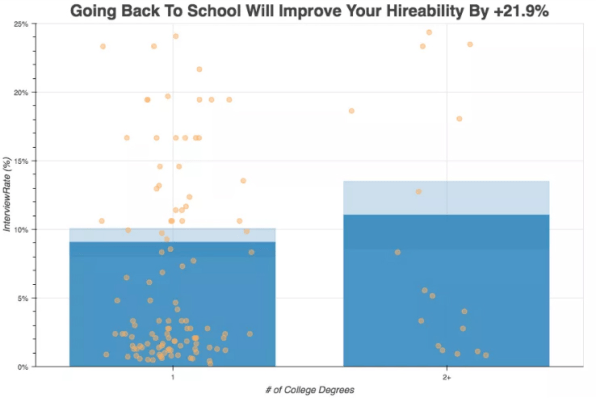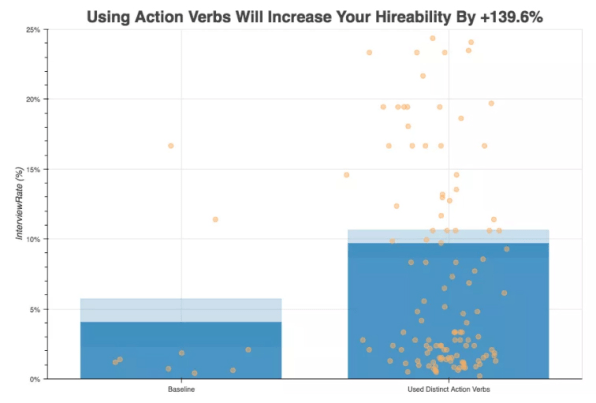#CareerAdvice : #ResumeWriting – 4 Metrics Recruiters Love to See on #Resumes … If you Want to Make Sure your #Resume Catches a #Recruiter’s Eye, There are Few Better Ways to Do So Than by Adding Metrics to It. Why?
For one, “we know that the human eye processes numbers faster than words,” career expert J.T. O’Donnell said in an interview with Glassdoor. But beyond that, they also “help me as a recruiter give context to the size and scope of the work that you did,” O’Donnell explains.
In any given workday, though, there’s no shortage of specific numbers you could call out: the amount of emails you send, the amount of meetings you attend, the amount of projects you work on. So how do you know which metrics to include?
We use the following four-step framework in our Job Seeker’s Toolkit to help you decide which numbers pack the most punch. Once you add the right metrics throughout your resume, don’t be surprised if the interview offers start rolling in!
1. Growth: What did you add to the company?
When deciding which metrics to include, it’s important to think about the key performance indicators, or KPIs, for your role. For example, salespeople are often assessed on how much revenue they drive, how many new clients they bring in, how many of their customers renew, etc. Whatever your role, think about the numbers that matter most for you: perhaps they’re ones that your boss brings up in weekly meetings, that you find in your performance review, or even that you see in the LinkedIn profiles of people with the same job title as you.
Of these different metrics, think about which ones represent ways you added to the company and helped it grow. Depending on your role, this might include:
- Website visits
- Revenue
- Deals closed
- Partnerships secured
- Candidates hired
- New technologies/processes adopted
Examples:
- Authored 150 articles over the course of one year, driving 500,000 unique website visits
- Vetted and reached out to roughly 30 prospects per day, resulting in 20 closed deals in Q1 and $120,000 in revenue (+22% to quota)
- Optimized 15 landing pages during the course of the internship, resulting in 17% lift in organic search traffic
Like this Article ? Share It ! You now can easily enjoy/follow/share Today our Award Winning Articles/Blogs with Now Over 2.5 Million Growing Participates Worldwide in our various Social Media formats below:
FSC LinkedIn Network: www.linkedin.com/in/fscnetwork
Facebook: http://www.facebook.com/pages/First-Sun-Consulting-LLC-Outplacement-Services/213542315355343?sk=wall
Google+: https://plus.google.com/115673713231115398101/posts?hl=en
Twitter: Follow us @ firstsunllc
Question: Want the ‘the best/current articles/blogs on the web’ on Job Search, Resume, Advancing/Changing your Career, or simply Managing People?
Answer: Simply go to our FSC Career Blog below & type(#career, #leadership, #life) in Blog Search: https://www.firstsun.com/fsc-career-blog/
What Skill Sets do You have to be ‘Sharpened’ ?
Continue of article:
2. Reduction: What did you help the company save?
In many cases, what you help your company reduce or eliminate can be just as important as what you add to it. In fact, certain roles focus their energy entirely on helping companies save or reduce in order to operate more efficiently. Think about whether you have a concrete way to measure how you’ve helped your company save or reduce the following:
- Time
- Budget
- Client turnover
- Employee turnover
- Website bounce rate
Examples:
- Identified three major bottlenecks in the hiring process and spearheaded taskforce to implement new technologies and strategies to overcome them, resulting in 31% faster time-to-hire
- Led website architecture redesign, leading to a two-second faster load time and 16.5% decrease in bounce rate
- Conducted internal budget audit and discovered five key areas of redundant spending, saving $23,000 per year
3. Impact: How many people did your work help?
A great way to illustrate how much value you can add to a company is by showing them how many people you’ve previously helped. This doesn’t just have to be people outside of your company like users or clients; it can also include those within your company. Look through the following “people” metrics, and think about which ones might be relevant to your role:
- Number of team members you’ve led
- Number of users or customers your work impacted
- Number of stakeholders involved in a project
- Number of clients you managed
- Number of employees you supported (for a function like IT or HR)
Examples:
- Coached, mentored and led a team of seven direct reports on the factory floor to ensure top-notch quality of products used by millions of consumers
- Conceptualized and executed a multi-touch blog, social and email marketing campaign that reached 200,000 unique impressions
- Oversaw both day-to-day and strategic HR operations for a company of 75 people
4. Frequency: How often did you complete tasks?
Understanding how frequently you performed certain tasks goes a long way in helping recruiters and hiring managers reading your resume understand how well-versed you are in a given area — often, the only difference between being a novice and being an expert is how much time you spend practicing.
To help you figure out which tasks are the most important to highlight, take a look in the job description to see which key responsibilities and skills are listed. For example, a job seeker applying to a position that lists analytical skills as a requirement might want to describe how they pulled weekly site traffic reports using Google Analytics, while someone applying to a PR position that mentions media relations skills in the job description may want to describe how they pitched reporters on a daily basis.
Samples:
- Spent 75% of each day utilizing Python, R and SQL to analyze large volumes of data to influence decision-making processes
- Analyzed performance metrics, reviewed creative and brainstormed with internal stakeholders to develop and present 4 strategic social media plans per year
- Worked with facilities, IT and communications teams to set up and flawlessly execute company all-hands meetings every 2 weeks
If you’re not used to adding numbers to your resume, it may feel a little bit strange at first. But don’t worry — you’ll get the hang of it in due time. Best of all, there’s a real chance it will improve your odds in a job search.
“Numbers make a huge difference. If you can quantify what you did in any way, you should,” O’Donnell said.
GlassDoor.com | |













